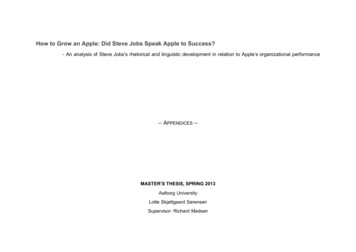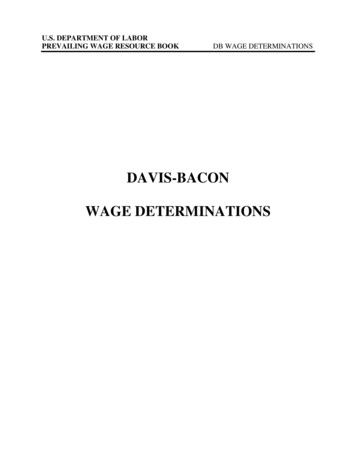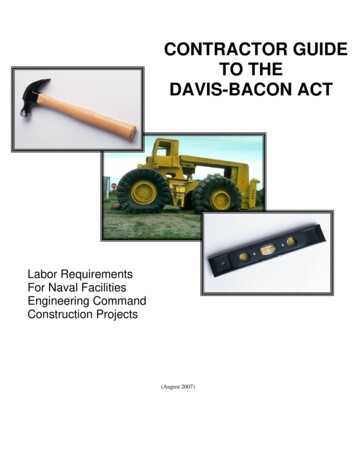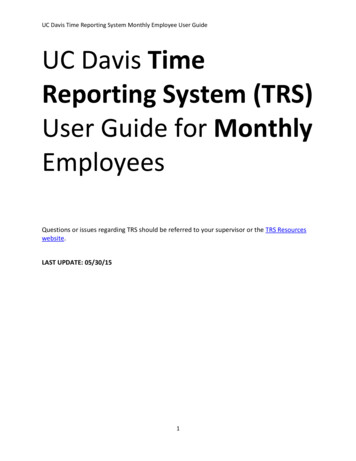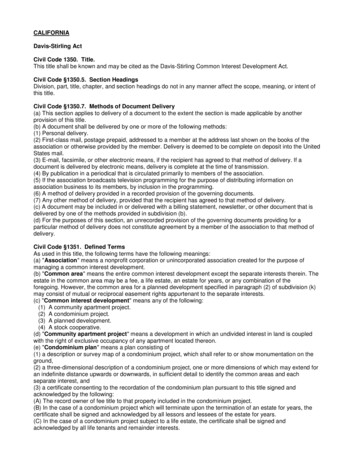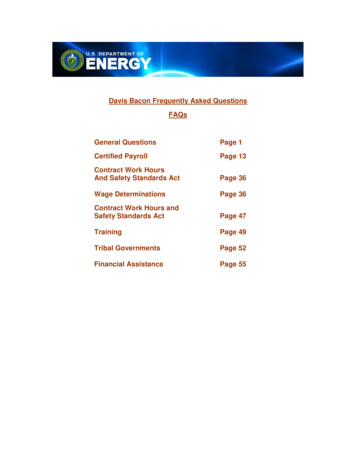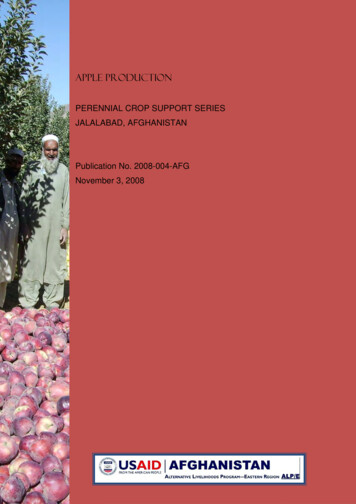
Transcription
APPLE PRODUCTIONPERENNIAL CROP SUPPORT SERIESJALALABAD, AFGHANISTANPublication No. 2008-004-AFGNovember 3, 2008Page 1 of 44
This manual was produced by Roots of Peace under USAID subcontract No. GS-10F-0359M, Task Order#306-M-00-05-00515-00, Afghanistan Alternative Livelihoods Program for the Eastern Region. It was writtenby Ferenc Sandor of Roots of Peace, with support from Juan Estrada of DAI for the use by Roots of Peaceand Ministry of Agriculture, Irrigation and Livestock extension agents, farmers, agriculture input suppliers andother teachers. The work was funded by USAID under the Alternative Livelihoods Program, Eastern Regionwhich is managed by Development Alternatives, Inc. (DAI). For more information, contact Roots of Peace atinfo@rootsofpeace.org or 1 415 455 8008.Roots of Peace is a humanitarian, not-for-profit organization based in California, USA. Roots of Peace,established in 1997, focuses on post-conflict countries to eradicate remnants of war and to re-establish andpromote economic livelihoods and social programs. Roots of Peace is funded by public and private sources.First published in Afghanistan in 2008 by Roots of Peace. Contents may be reproduced without approval bynot-for-profit organizations provided appropriate recognition of author, artist and photographers is included inthe document. Any for profit organization application of these materials must be approved by Roots of Peacein writing prior to use.Page 2 of 44
TABLE OF CONTENTS123Introduction . 4Scientific Classification . 4Morphology. 53.1 Main Characteristics of Apples . 53.1.1Shape . 53.1.2Axis . 53.1.3Tube Stamens . 53.1.4Tube . 63.1.5Carpals . 63.1.6Eye . 64Apple Classification Systems . 64.1 Dr. Diel’s first natural classification system (Germany, 1792). 64.2 Diel-Dochnahl classification system (Germany, 1855) . 74.3 Diel-Lucas classification system . 74.4 Double classification system . 84.5 John Warder American classification system (1867) . 84.6 J. Thomas classification system (USA, 1849). 94.7 English artificial classification system (1876) . 95Soil Preparation . 96Planting Apple Trees. 107Orchard Layout . 108Fertilizing Apple Trees . 118.1 Nitrogen status. 118.2 Phosphorus status . 128.3 Potassium status . 139Pest and Disease Management . 1510 Irrigation . 1811 Pruning Apple Trees . 1811.1Root stock . 1911.2Principles of pruning apple tree . 2211.3The growing habits of apple trees. 2511.4Pruning cuts . 2511.5Pruning young apple trees . 2611.6Training the apple tree . 2611.6.1 Central leader system . 2611.6.2 Open center system . 2811.6.3 Slender, spindle-type system . 2811.6.4 Cordon type system. 2911.7Pruning bearing trees . 3012 Harvest . 3213 Apple Varieties . 3314 References . 41Page 3 of 44
1 IntroductionApple is a temperate climate fruit. They are native in many parts of Europe and Asia temperateclimates. The origin of apple is Central-Asia, and Afghanistan has many areas with native apples.Wild apple varieties, such as Malus pumila, Malus silvestris and Malus orientalis are the mostprevalent. In 1997, an amazing 44.7 million metric tons of apples were produced for humanconsumption. In 2006, production was 44.1million metric tons. The leading apple growing country isChina, producing about 41percent of the world's apples, followed by the United States.In this context the Afghan fruit producer sector can play a significant role covering the local andinternational market of the region. The Afghan apples from the southern and eastern regions areexcellent quality for export to many countries in the region, which are, because the climatecondition, are not able to satisfy the market demand in term of quality standards.According to the FAO survey: “Afghanistan has proven favorable climatic conditions for theproduction of apple trees. The more accessible areas and local markets have heavy competitionfrom imported fruits from Iran and Pakistan. Nevertheless, cultivation is still widespread and mainlyaimed at satisfying the small rural local markets and the farmers’ subsistence production. Thecurrent apple production in the country largely depends on the few exotic varieties imported 20years ago.” However, the quality of apple produced in Afghanistan is higher than the imported applequality from Pakistan or Iran.The proverb says: “If you want keep yourself in good health conditions, than eat an apple everyday.” This statement reflects the importance and demand for apple by the food market. Appleproduction is not only important for the fresh fruit market, but it also develop favorable conditions forfruit processing industry, which is a significant step forward economy development in the country.Juice production and concentrate export is one of the most promising profit producer industries.From the world’s annual production in 2005, 36 percent of apples were processed into appleproducts; 18.6 percent of this is for juice and cider, 2 percent was dried, 2.5 percent was frozen,12.2 percent was canned and 0.7 percent was fresh slices. Other uses were the making of babyfood, apple butter or jelly and vinegar.In Afghanistan, apple production is done mainly by small-holder orchard owners. Statistics showsthat the apple production costs in Afghanistan is considerably lower than in other apple producercountries, therefore allowing the improved apple varieties to compete in international markets.2 Scientific usMalus domestica (Borkh)Malus sieversiiCentral AsiaPage 4 of 44
3 MorphologyThe tree naturally grows between 5m and 12m tall. The leaves are arrangedalternately along the shoot. Their shape is a simple oval. The leaf is 5 to 12cmlong and 3 to 6cm wide attaching to a 2-5cm long petiole with an acute tip. Theflowers have five petals with a size approximately 3cm. The color of the flowers iswhite with a pink tinge. The fruit contains five carpals arranged in a five point star.Each carpal contains 1 to 3 seeds.Source: F.Sandor (2009)3.1 Main Characteristics of Apples3.1.1 ShapeThe main shape types are: roundish, oblate, conical, and oblong. Roundishindicates that the height and diameter of the fruit are nearly equal. Oblateindicates that the height is much less than diameter. Conical, is when thefruit is roundish, having the apex end contracted. Oblong, is when the fruit islonger than broad, and having the apex and base of nearly the samebreadth. Truncate conic, is when the fruit is flattened at the apex. Ribbed, orobscurely ribbed, when the surface has rising lines and channels from apexto base. Oblique, is when the fruit presents the appearance as of being onesided, or when the axis is inclined to one side. Oblate fruit is when one sideis less than the other. Corrugated apple means that it contains depressedlines, furrows, or wrinkles. Acute, when the fruit is narrowing to a sharp point. Abrupt fruit meansthat the depressed lines break off suddenly.Source: Malus sieversii3.1.2 AxisThis is an imaginary straight line between the stem and the centre of the calyx. The axis is inclinedwhen the fruit is oblique or lop-sided; short when oblate or the cavity and basin are deep; long whenthe fruit is oblong. The core-cells are axial when they meet the axis; abaxial when distant from it.When a section made through the apples at right angles to the axis is circular, it is regular; if so, itcould be turned in a lathe, meaning it is very regular; it may be irregular, compressed, or flattenedsidewise, angular, furrowed, or ribbed, rarely triangular, quadrangular, or pentangular.3.1.3 Tube StamensThe stamens can occupy three different positions in the tube. The position is marginal when thestamens are placed close to one of the two ends of the tube: marginal near to the outer end ormarginal near to the inner end. The third position relates to when the stamens are placed near tothe middle section of the tube (median).Page 5 of 44
3.1.4 TubeIn case of conical fruit, the outlines from the base of the sepals turn in on a curved line inwards towards the core, forming a cone. These curves are generally made inward, but occasionally theyare seen outwards. When funnel-shaped, the outlines are seen in a hollow cavity like the stem of afunnel.3.1.5 CarpalsThis is the core of the apple fruit. Usually the fruit contains five carpals, each one ofthem with 1 to 3 seeds. Its shape can be round, ovate, obovate or elliptical.Source: M.Cranshaw(2005)3.1.6 EyeThe sepals are commonly called the eye of the apple. When the fruit develops, the segments fromthe original calyx stay and gradually assume various directions. When the fruit matures, thesegments take four distinct forms. When the segments are reflexed or recurved, it is known as thedivergent form. When the segments are erected and pointed, the form is erect convergent. Flatconvergent is formed when the segments are closing over the eye without overlapping each other.When the segments are overlapping each other, this forms a compact cone, making the eyeconnivent.There are other characteristics like the size of the apple, its surface or the appearance of dots. Thestem can also brown or green colored and its form can be straight, curved, fleshy or knobbed.Cavity is the depression in which the stem is inserted, and may be wide, deep, shallow, regular,irregular, wavy, uneven, or folded. In a few varieties, the cavity is nearly or quite filled up, and isthen termed f
climates. The origin of apple is Central-Asia, and Afghanistan has many areas with native apples. Wild apple varieties, such as Malus pumila, Malus silvestris and Malus orientalis are the most prevalent. In 1997, an amazing 44.7 million metric tons of apples were produced for human consumption. In 2006, production was 44.1million metric tons. The leading apple growing country is
